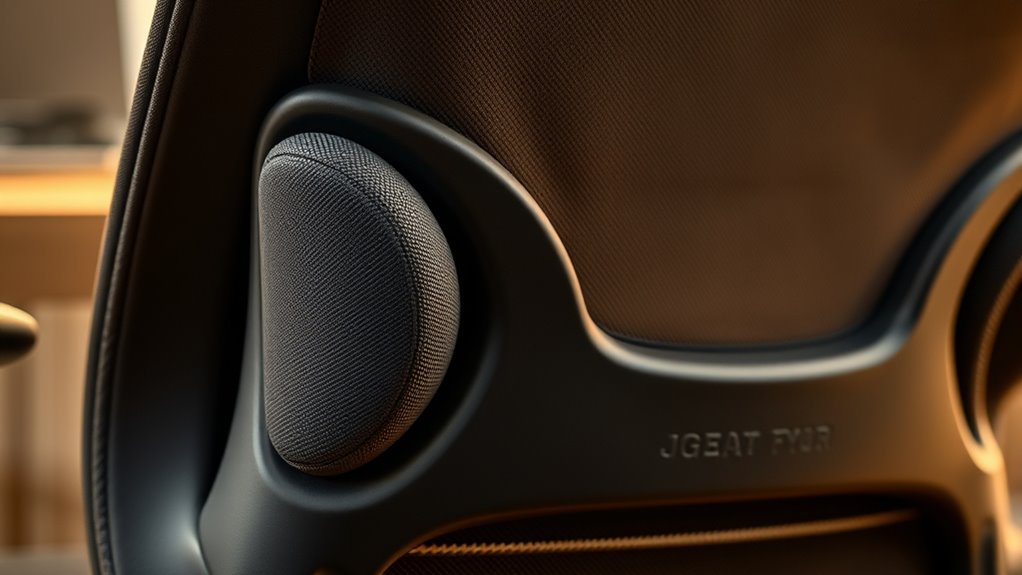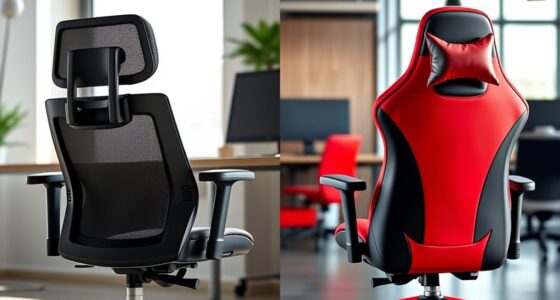Lumbar support is a must for office chairs because it helps maintain the natural curve of your lower back, preventing strain and reducing discomfort during long sitting periods. Proper lumbar support encourages good posture, which minimizes muscle fatigue and chronic back pain. It also promotes spinal health and improves focus, leading to better productivity. By understanding its benefits, you’ll see how the right support can make your workspace more comfortable and healthier—you’ll learn more about getting it just right.
Key Takeaways
- Lumbar support maintains the natural curve of the lower spine, preventing misalignment and promoting spinal health during extended sitting.
- Proper lumbar support reduces back muscle strain and discomfort, enhancing overall comfort and productivity at work.
- It helps prevent long-term issues like back pain, neck stiffness, and headaches caused by poor posture.
- Adjustable lumbar supports ensure personalized fit, encouraging ergonomic sitting habits and reducing fatigue.
- Incorporating lumbar support supports better posture, decreasing physical distractions and enabling longer, focused work sessions.
Understanding the Importance of Proper Spinal Alignment

Maintaining proper spinal alignment is vital for preventing discomfort and long-term health issues. When your office chair has an ergonomic design, it naturally encourages posture correction, helping your spine stay aligned. Proper alignment reduces stress on your vertebrae, muscles, and ligaments, preventing strain and fatigue. By supporting the natural curve of your lower back, a well-designed chair promotes better posture throughout the day. This not only feels more comfortable but also minimizes the risk of developing chronic back problems. Remember, good spinal alignment isn’t just about comfort; it’s essential for your overall health. Investing in an ergonomic chair with lumbar support ensures your spine remains properly aligned, making long hours at your desk less taxing on your body. Additionally, understanding the horsepower of electric dirt bikes can help you choose the right equipment for your needs and safety considerations.
How Lumbar Support Reduces Lower Back Pain
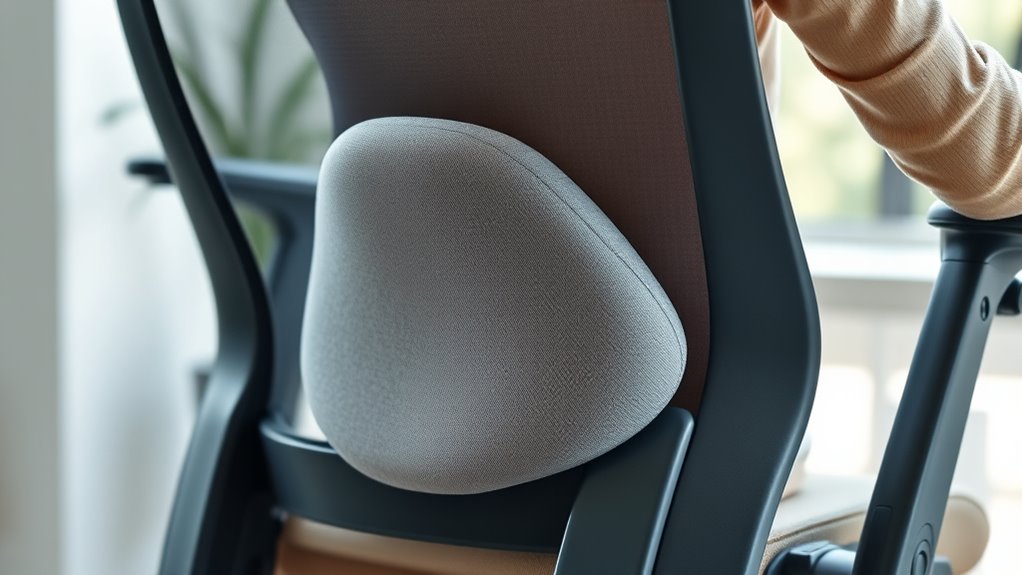
Lumbar support helps keep your spine properly aligned, reducing unnecessary stress on your lower back. When your muscles don’t have to work overtime to support your posture, you’re less likely to experience pain or fatigue. By maintaining this alignment, lumbar support prevents muscle strain and keeps you comfortable throughout the day. Additionally, proper lumbar support can enhance overall posture and reduce the risk of chronic back issues over time.
Maintains Spinal Alignment
When your office chair provides proper lumbar support, it actively helps keep your spine in its natural curve. This alignment is essential for maintaining spinal health and preventing long-term issues. Lumbar support ensures that your lower back isn’t slouched or overly arched, which can cause misalignment over time. Using ergonomic cushions can enhance this support, adapting to your unique shape and promoting proper posture. When your spine stays properly aligned, you reduce strain on surrounding muscles and ligaments, helping you stay comfortable and focused throughout the day. Proper lumbar support creates a stable foundation, encouraging correct positioning and minimizing the risk of developing postural problems. Additionally, attention in creative practice can be cultivated to improve your focus on maintaining proper posture during long work hours. Ultimately, maintaining spinal alignment with lumbar support is key to a healthier, pain-free back.
Prevents Muscle Strain
Proper lumbar support actively reduces muscle strain by distributing your weight evenly across your lower back. When your chair includes ergonomic accessories like lumbar cushions, it encourages better posture correction, preventing uneven muscle tension. Without proper support, muscles work harder to keep you upright, leading to fatigue and discomfort. Lumbar support ensures your spine stays aligned, minimizing unnecessary muscle engagement. This helps you avoid strain and reduces the risk of lower back pain caused by prolonged sitting. By maintaining proper posture, you lessen the likelihood of muscle fatigue and soreness. Investing in an office chair with quality lumbar support is essential for supporting your lower back and promoting healthier sitting habits, ultimately keeping your muscles relaxed and pain-free throughout the day. Additionally, best heat pump technology can optimize your workspace environment, contributing to overall comfort and reducing physical stress during long hours.
The Impact of Poor Posture on Your Health
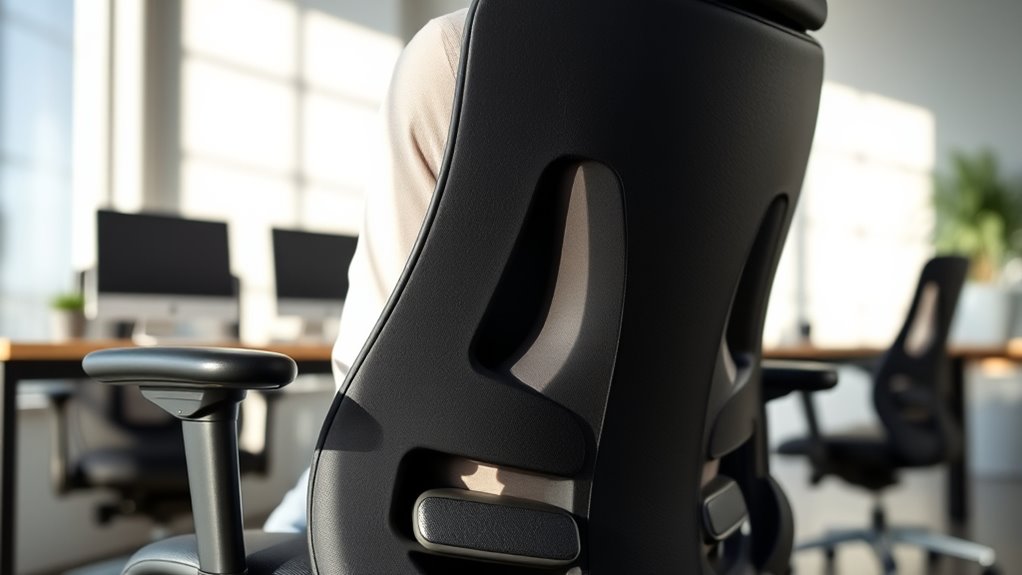
Poor posture can markedly affect your health by putting unnecessary strain on your muscles, joints, and internal organs. Over time, this can lead to chronic pain, reduced mobility, and even digestive issues. Without proper ergonomic accessories or posture correction, you might develop spinal misalignments that worsen your discomfort. To understand this better, consider the following:
| Effect | Cause | Result |
|---|---|---|
| Back pain | Slouching at your desk | Muscle fatigue |
| Neck stiffness | Poor screen height | Headaches |
| Reduced lung capacity | Hunching forward | Breathing difficulties |
| Digestive problems | Sitting with poor posture | Discomfort and bloating |
| Fatigue | Straining muscles | Decreased productivity |
Prioritizing good posture through ergonomic accessories helps prevent these health issues. Proper ergonomic setup can make a significant difference in maintaining spinal health and overall well-being.
Key Features to Look for in Office Chair Lumbar Support
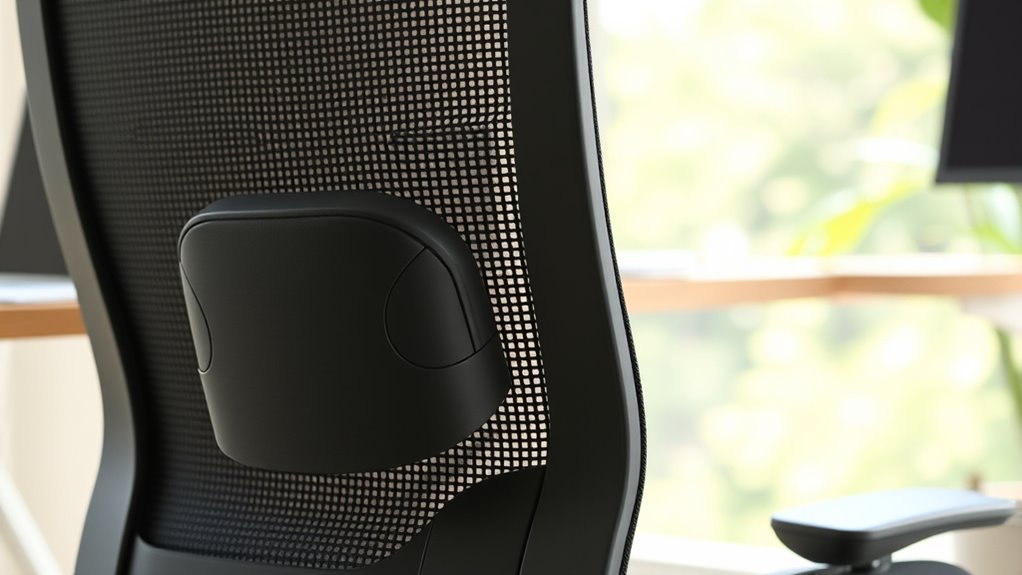
When choosing lumbar support, look for adjustable height and depth to guarantee a custom fit. The contour and shape should match your lower back’s natural curve for better comfort. Also, consider breathable materials to keep you cool during long work hours.
Adjustable Height and Depth
Have you ever felt discomfort during long hours at your desk? If so, adjustable height and depth features are essential. An ergonomic design allows you to customize the lumbar support to fit your body perfectly, reducing strain. By adjusting the seat height, you can ensure your feet rest flat on the floor and your knees are at a comfortable angle. The depth adjustment lets you move the lumbar support closer or farther from your lower back, providing targeted support where you need it most. These features help distribute your weight evenly, promoting better posture and preventing discomfort. When shopping for an office chair, prioritize models with intuitive, easy-to-use adjustments so you can fine-tune your lumbar support for maximum comfort during long work sessions. Proper lumbar support is crucial for maintaining spinal health and reducing fatigue during extended periods of sitting.
Contour and Shape Fit
A well-designed lumbar support that contours to your lower back guarantees a comfortable, natural fit. When evaluating shape fit, prioritize ergonomic design, guaranteeing the support follows your spine’s natural curve. This tailored fit enhances user comfort by reducing pressure points and promoting proper posture. Look for supports with adjustable contours, so they adapt to your unique shape. The following table highlights key features:
| Feature | Benefit |
|---|---|
| Contoured Shape | Provides personalized fit for ideal support |
| Flexible Material | Enhances adaptability to your lower back’s curve |
| Ergonomic Design | Promotes proper spinal alignment |
| User Comfort | Prevents fatigue and discomfort during long hours |
Choosing a lumbar support with a contour that fits your shape ensures better ergonomics and sustained comfort.
Breathable Material Options
Are you seeking lumbar support that keeps you comfortable even during long hours at your desk? Breathable fabric options are essential for preventing discomfort and sweat buildup. Look for lumbar supports made from moisture-wicking materials, which draw sweat away from your skin and keep you dry. Consider these key features:
- Breathable fabrics that promote airflow and reduce heat buildup
- Moisture-wicking materials that keep you dry and comfortable
- Ventilated designs that enhance circulation and prevent overheating
- Incorporating high-quality materials ensures durability and sustained breathability over time.
Choosing lumbar support with breathable fabrics ensures you stay cool and comfortable, even during extended work sessions. These features help maintain proper posture without sacrificing comfort, making your workspace more ergonomic and pleasant.
The Connection Between Lumbar Support and Productivity

When your office chair provides proper lumbar support, it helps maintain correct posture, reducing discomfort and fatigue during long work hours. This ergonomic design ensures your sitting posture stays aligned, preventing slouching or strain. When you’re comfortable and supported, your focus sharpens, and productivity naturally improves. Proper lumbar support minimizes physical distractions caused by back pain or soreness, allowing you to stay engaged with your tasks. Additionally, good posture reduces the risk of long-term musculoskeletal issues, meaning you can work longer without discomfort. Investing in a chair with lumbar support isn’t just about comfort; it directly impacts your efficiency, concentration, and overall work performance. When your body is well-supported, your productivity levels stay high throughout the day. Personal development techniques like mindfulness and self-reflection can also enhance your focus and overall well-being at work.
Common Misconceptions About Lumbar Support
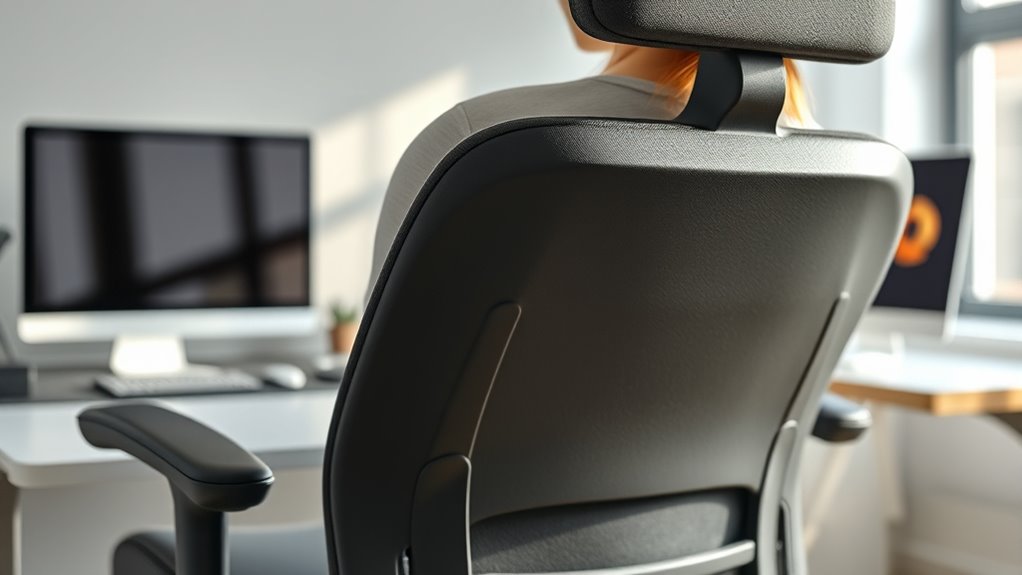
Many people believe that all lumbar supports are the same, but that’s not true. Some assume proper adjustment is obvious, yet it often requires fine-tuning for comfort. Clearing up these misconceptions can help you get the most benefit from your chair’s lumbar support. Additionally, choosing the right type of filter and ensuring proper placement can significantly enhance the overall effectiveness of your lumbar support and improve your sitting posture.
Lumbar Support Myths
Have you ever believed that lumbar support is a one-size-fits-all solution? Many think it instantly cures back pain or automatically corrects posture. That’s a myth. In reality, lumbar support isn’t a magic fix; it’s a tool that requires proper use. Here are some common misconceptions:
- Lumbar support guarantees back pain relief without proper adjustment.
- All lumbar supports are the same, regardless of your body shape.
- Using lumbar support means you don’t need to focus on overall posture correction.
In truth, lumbar support helps maintain the natural curve of your spine, but only if positioned correctly. It’s not a substitute for good posture habits. Proper adjustment and awareness are key to reducing discomfort and preventing long-term back pain.
Proper Adjustment Confusion
Proper adjustment of lumbar support often causes confusion, leading people to believe it’s a simple task. In reality, achieving optimal ergonomic design requires attention to detail. Many think a quick tweak suffices, but proper posture correction depends on precise positioning. To clarify, here’s a helpful guide:
| Adjustment Area | Ideal Position | Purpose |
|---|---|---|
| Height | Supports lower back’s curve | Maintains natural spine shape |
| Depth | Fits into lumbar curve | Prevents slouching |
| Firmness | Provides gentle support | Encourages proper posture |
Additionally, understanding how lumbar tuning influences overall comfort can help you make better adjustments.
The Long-Term Benefits of Using Lumbar Support

Using lumbar support consistently over the long term can markedly reduce the risk of developing chronic back pain and spinal issues. By maintaining an ergonomic posture daily, you promote better spinal alignment and prevent strain. Over time, this leads to improved long-term health, keeping your back strong and flexible. Proper lumbar support can also help prevent posture-related problems, ensuring you maintain healthy spinal curves. Consider these benefits: 1. Reduced incidence of chronic back pain 2. Enhanced spinal health and flexibility 3. Better posture habits that last a lifetime When you prioritize lumbar support, you’re investing in your long-term well-being. It helps you avoid discomfort and injury, ensuring you stay comfortable and healthy during extended work sessions. Consistent use supports your spine’s natural curve, making your workday less stressful on your back.
Tips for Adjusting and Maintaining Your Lumbar Support
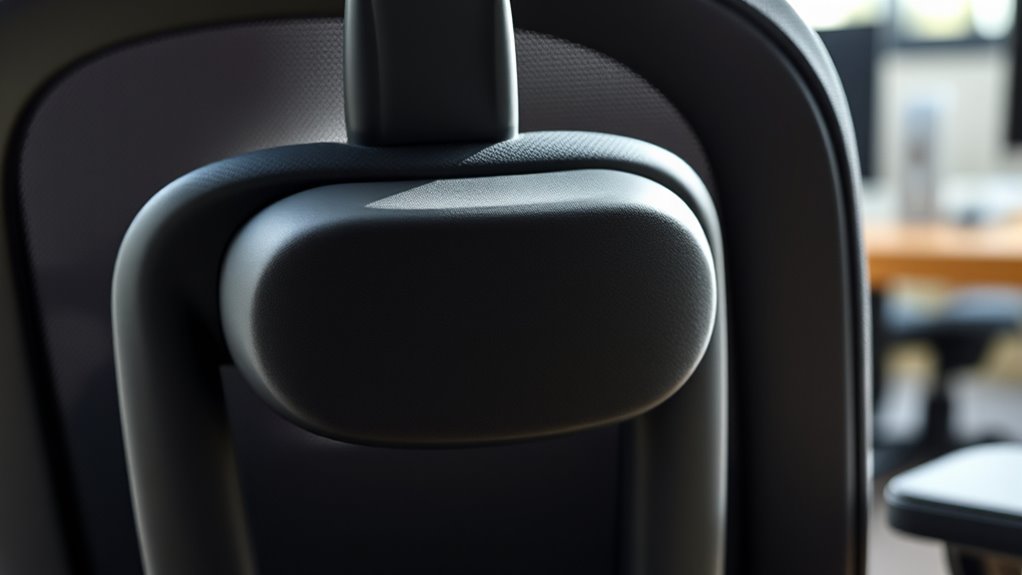
Maintaining your lumbar support properly guarantees you reap its full long-term benefits. First, regularly adjust the height and firmness to match your lower back’s natural curve. Many ergonomic accessories come with simple adjustment features—use them to guarantee ideal support. Check that your lumbar support stays in contact with your spine, not just your backrest. Incorporate posture exercises into your routine, as they can strengthen your core and improve your sitting habits, reducing strain on your lumbar area. Keep the lumbar cushion clean and free from dust or debris, which can degrade its effectiveness. Periodically reassess your setup to confirm your lumbar support continues to suit your posture. To ensure optimal comfort and durability, consider using high-quality materials that are designed for long-term use. Proper adjustment and maintenance maximize comfort and help prevent discomfort or injury over time.
How to Choose the Right Office Chair With Lumbar Support
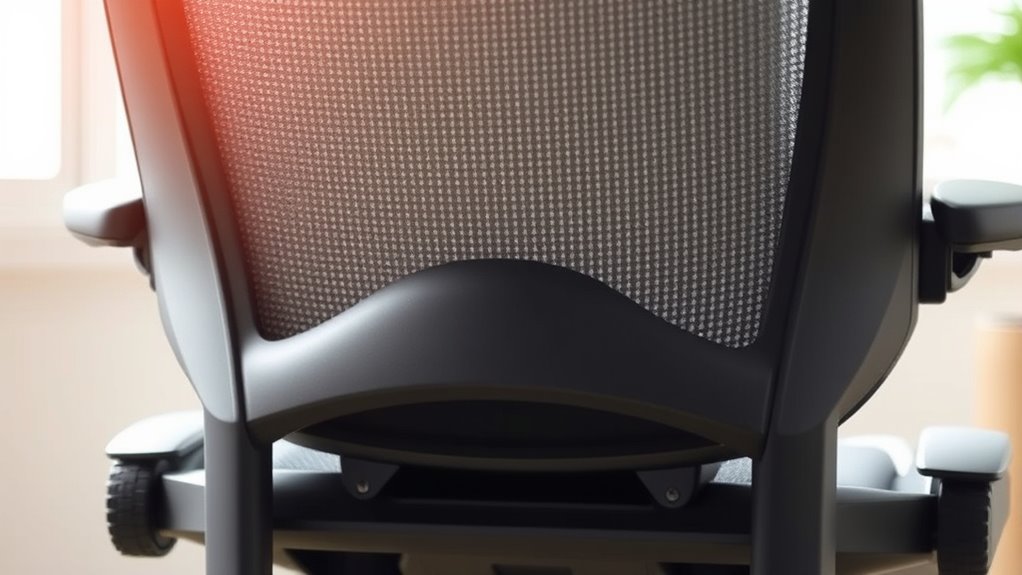
Choosing the right office chair with lumbar support starts with prioritizing adjustable features that fit your body. Focus on ergonomic design elements that promote proper posture and comfort. When selecting a chair, consider these key factors: Kia Tuning and the specific enhancements available for different models.
Incorporating Lumbar Support Into Your Workspace for Maximum Comfort

Incorporating lumbar support into your workspace can substantially boost comfort and reduce strain during long hours at your desk. Start by choosing an ergonomic design that offers adjustable lumbar support, ensuring it fits your natural curve. Position the support so it directly contacts your lower back, promoting proper posture correction. Use ergonomic accessories like lumbar cushions or adjustable chairs if built-in support isn’t available. Keep your monitor at eye level and maintain a neutral wrist position to complement your lumbar setup. Regularly adjust your chair and lumbar support to stay aligned throughout the day. This proactive approach helps prevent discomfort, improves posture, and creates a healthier, more productive workspace. Proper lumbar support isn’t just a luxury—it’s essential for all-day comfort. Incorporating ergonomic resources can further enhance your setup and promote better spinal health.
Frequently Asked Questions
Can Lumbar Support Prevent Chronic Back Issues Over Time?
Yes, lumbar support can prevent chronic back issues over time. It promotes proper ergonomic design, ensuring your spine stays aligned and reduces strain. When your posture is well-maintained with lumbar support, you lessen the risk of developing long-term back problems. Investing in an office chair with good lumbar support helps you stay comfortable and keeps your posture aligned, which is essential for preventing chronic discomfort and injury.
Are There Different Types of Lumbar Support Suitable for All Body Types?
There are different types of lumbar support designed for all body types, often featuring ergonomic design and adjustable features. You can find contoured cushions, built-in supports, or inflatable options that adapt to your spine’s curve. By choosing a support with adjustable height and firmness, you guarantee a personalized fit, helping reduce discomfort and promote proper posture, regardless of your body shape or size.
How Often Should I Replace or Adjust My Lumbar Support?
You should check your lumbar support regularly as part of your maintenance schedule. Adjust it whenever you notice discomfort or poor posture, ideally every few months. Keep an eye on signs of wear or looseness, and replace it if it no longer provides proper support. Making ergonomic adjustments guarantees your chair remains comfortable and supportive, helping prevent long-term back issues and maintaining good posture during your workday.
Does Lumbar Support Benefit People With Existing Back Injuries?
When it comes to back injuries, don’t underestimate the power of proper ergonomic adjustments. Lumbar support can be a game-changer, helping with posture correction and reducing strain. If you already have a back injury, using lumbar support in your office chair provides targeted relief, like a safety net catching you when you stumble. It’s a smart move to support your recovery and keep your back healthier long-term.
Can Portable Lumbar Supports Be as Effective as Built-In Chair Supports?
When comparing portable versus built-in lumbar supports, you might wonder which offers better effectiveness. Portable supports can be quite effective because you can adjust them to fit your back perfectly, providing targeted support. However, built-in supports often offer consistent positioning and durability. Ultimately, your choice depends on your mobility needs and comfort preferences. Both options can improve your posture, but consider your daily routine to determine which works best for you.
Conclusion
Think of your spine as the sturdy trunk of a tree, supporting everything else. Without proper lumbar support, you’re risking cracks and damage that could weaken your foundation. But with the right support, your posture stays strong, your back stays healthy, and your productivity soars. Don’t let poor support be the storm that topples your tree—invest in lumbar support today to keep your workday rooted in comfort and strength.
